mount fanjing
Fanjingshan: National AAAAA-level tourist attractions, National Nature reserves, China's top ten summer resorts, China's famous Maitreya Bodhisattva Dao, a member of the International Network for the Protection of Man and the Biosphere (MAB), and a World Natural Heritage site recognized by the 42nd World Heritage Conference.
Fan Jing Mountain, named "Fantian Pure Land", is located at the junction of Jiangkou, Yinjiang and Songtao in Tongren City, Guizhou Province. It is the main peak of Wuling Mountains at an altitude of 2493 meters. Its forest coverage rate is 95%. It is a rare Buddhist Taoist temple and Nature Reserve in China. It is also known as the five famous Buddhist mountains in China, along with Wutai Mountain, Putuo Mountain in Zhejiang Province, Emei Mountain in Sichuan Province and Jiuhua Mountain in Anhui Province.
The primitive floods and wilderness are the landscape features of Fanjing Mountain. The four wonders of the sky, namely, cloud falls, Zen fog, phantom and Buddha light, add mysterious color to Fanjing Mountain. The landmark scenic spots include Hongyun Jinding, Yuejingshan, Wanmi Sleeping Buddha, Mushroom Stone, Ten Thousand Volumes of Sutras, Kowloon Pool, Phoenix Mountain, etc.
There are more than 2000 species of plants, 31 species of national protected plants, 801 species of animals and 19 species of national protected animals in Fanjing Mountain. It is known as the Earth's oasis, the gene bank of animals and plants, and the precious heritage of human beings. With the momentum of Mount Hua, the magnificence of Mount Tai and the marvelous stone of Rabbit's Ear Ridge, it is a tourist resort.
Fanjingshan is the most unique landmark in Guizhou Province. It is Lingshan Mountain in eastern Guizhou. It is an ecological kingdom, a scenic resort and a pure land. It is a wonderland and natural oxygen bar for returning to nature, refreshing body and mind, and revering people's imagination. The famous poet Wang Xinjian's poem "Crossing Fan Jing Shan" says that the only way to get rid of vulgarity is the sound of bamboo. Habitat in Pure Land, Push Clouds and Step into Brahman. Zen fog into the valley, Buddha light on the rock. Those who follow the Taoist path in the sea often come to continue the fairy margin." That is to say, it confirms the charming scenery of Fanjingshan Mountain, which makes people forget the troubles of the world.
On July 2, 2018, Fanjingshan Mountain, Guizhou Province, China, was admitted to the World Heritage List at the World Heritage Conference held in Manama, Bahrain.
Survey of scenic spots
Fanjingshan Nature Reserve in Guizhou Province is located at the junction of Jiangkou, Yinjiang and Songtao Counties in Tongren City, Guizhou Province, with a total area of 4190 hectares, including 25800 hectares in the core area, 2800 hectares in the buffer area and 13300 hectares in the pilot area (including 1200 hectares in the tourist area). The main protected objects are rare wildlife and native forest ecosystems represented by Rhinopithecus roxellanae brelichi and Davidia involucrate Baill. Forest coverage is 90%.
Fanjing Mountain is the main peak of Wuling Mountains. The highest elevation of Fenghuang Mountain is 2572 meters (Hongyun Jinding Mountain is 2494 meters). It has obvious monsoon climate characteristics in the middle subtropical mountains. This area is a gathering place of various floristic geographical elements, rich in plant species, ancient and relic species, diverse vegetation types and distinct vertical band spectrum. It is a typical primary vegetation preservation site in the central subtropical mountains of Western China. There are more than 2,000 species of plants in the area, of which there are more than 1,000 higher plants. Among them, 21 species of national key protected plants are Davidia involucrata, and a large area of Davidia involucrata is found. There are 382 species of vertebrates, including 14 species of national key protected animals such as Guizhou golden monkeys, which are the only districts of Guizhou golden monkeys.
There are four climatic zones, five vertical soil types and forest zones, evergreen warm coniferous forest and bamboo forest, evergreen broad-leaved forest, evergreen deciduous broad-leaved mixed forest, deciduous broad-leaved forest to coniferous and broad-leaved mixed forest in the same latitude on the earth, while at the top of the mountain, it is formed strong due to altitude, cloud, humidity, wind and other reasons. Low dwarf forest. More than 40 species of animals and plants have been included in the protection, which is called "gene bank" of biological resources and "precious heritage of mankind".
On July 2, 2018, Fanjingshan Mountain, Guizhou Province, China, was admitted to the World Heritage List at the World Heritage Conference held in Manama, Bahrain.
On October 17, 2018, the Ministry of Culture and Tourism publicized nine national 5A-level tourist attractions, including Fanjingshan.
geographical position
Fanjingshan area is very large. It is located in Jiangkou County, Yinjiang County and Songtao County, Tongren City, Guizhou Province (5 Fanjingshan Mountain, Tongren City, Western Guizhou Province).
Southern) at the junction of three counties, near Jiangkou County, southeastern Yinjiang County and southwestern Songtao County.
It has a series of scenic spots, the highest peak of which is Jinding. The Jinding area is the area of Fanjingshan Eco-Botanical Garden.
Geology and geomorphology
Fanjingshan is the first peak on the slope of the transition from Yunnan-Guizhou Plateau to Western Hunan hills (the difference between the foot of the mountain and the top of the mountain is up to 2000 meters). It is not only the watershed between Wujiang River and Yuanjiang River, but also the highest peak of Wuling Mountains across Guizhou, Chongqing, Hunan and Hubei provinces (regions).
Fanjingshan is the earliest ancient area in the south of the Yellow River in China, which was uplifted from the ocean to the land. During the long geological years, Fanjingshan has undergone many tectonic changes and Mesozoic orogeny, which has swept away the Jurassic fold belt in Echuan, Hunan and Guizhou provinces. Due to tectonic control, it has been in a strong uplift area since then, and has become the top of Wuling Mountain. The Mesoproterozoic Fanjingshan Group is a volcanic sedimentary rock series of continental rift basin-Red Sea Cenozoic basin, and the main peaks of the foothills and peaks are preserved by the fluctuating continental margin clastic sediments of the Upper Proterozoic Yubanxi Group-Xiajiang Group.
natural resources
Fanjing Mountain preserves a rare subtropical primary ecosystem in the world. It also left behind ancient and rare species between 70 million and 2 million years ago. There are 2601 species of organisms, including 1800 species of plants, 21 species of rare plants listed in the national key protection, accounting for 43% of the total protected plants in Guizhou Province; 801 species of animals, 382 species of vertebrates, 19 species of national key protected animals, accounting for 68% of the total protected animals in Guizhou Province. Fanjingshan also has many rare species, such as Guizhou golden monkey and Davidia involucrata.
Main attractions
Cotton Hill
The bus terminal and the starting point of hiking on the west side of Fanjingshan Mountain are 2000 meters above sea level. The new Jinding, the old Jinding and the Phoenix Mountain are in front of us.
Here we can see a great wonder of Fanjingshan --- ten thousand meters sleeping Buddha and Buddha in the middle of Buddha. The first three Buddhas and two Buddhas symbolize "five blessings come to the gate", and they are ten thousand meters long. They are the best in the world. They are very similar to Datumile Maitreya. For thousands of years, local people have called Fanjingshan "Great Buddha Mountain", which is a Buddha and Buddha, that is, a mountain.
Bestowing imperial tablet
In the forty-sixth year of the Ming Dynasty (1618), it was built according to the Divine Emperor's decree. Li Zhiyan, the household minister at that time, wrote about the geographical location, mountain topography, scenic spots, historical legends and the rise and fall of Buddhism. The inscription says that Fanjingshan is an ancient Buddhist temple, a "sect of the world's famous mountains", a "place where the vault of the upper dome meets the sky and the lower dome meets the sky", "Cui Wei does not diminish the five mountains and sows the Qianqiu witchcraft". It is famous in Nanjing and Beijing, attracting 13 provinces, and attracting royal ministers and the people of Li to come to worship the "Paradise Palace of Supreme Happiness", which is a key cultural relic protection unit in Guizhou Province.
Red cloud Golden Summit
The peak rises from the ground with a vertical height difference of 100 meters. The first half is divided into two parts, which are linked by overpasses. On each side, a temple is built. Sakyamuni Buddha is worshipped while Maitreya Buddha is worshipped. This confirms the alternation of modern Buddha (Sakyamuni) to future Buddha (Maitreya Buddha). In the morning, the red clouds are always around, known as the red clouds and golden tops.
Climbing up the tightrope, there are cliffs on all sides and ancient temple cliffs along the way. The main cliffs are Daoyuan in the first year of Wanli in Ming Dynasty and Gong De Tablet of Tianqiao in the fifty-second year of Kangxi in Qing Dynasty. Halfway through Lingguan Hall, leading stone, to the Guanyin Cave. Guanyin Cave is a stone cave on the cliff. It is built into a stone house hanging from the mountain. Under the stone house is a deep valley of ten thousand Zhangs, dedicating to Guanyin Bodhisattva. Guanyin Cave is also called "Daer Cave". It is said that good men and women who have not had children for a long time kowtow three rings to Jinding, and then throw a small stone into the cave of half waist of Jinding, they will get Buddha to give their children and grow up healthily. Outside the Guanyin Cave, there is a stone, the stone of rewarding kindness, engraved with four big characters of "no virtue, no reward". From the Guanyin Cave, it is "Golden Dao Gorge" and "A Line of Sky". On the cliff, there is a natural spring eye, the water of concentration.
Qianshan First Stone
Fanjing Mountain on the western line, after reaching the top meadow layer, stands on the top of the mountain like a praise of the thumb: you are the first! It is said that Yan Yinliang, a great calligrapher of the Qing Dynasty, wrote "Qianshan No. 1" on the plaque of the Summer Palace.
Sleeping Buddha
Ten thousand meters sleeping Buddha, supine on the top of Fanjing Mountain, as long as 10,000 meters, the world's largest. For thousands of years, people from all over the world have worshipped Fanjing Mountain as a great Buddha. A mountain is a Buddha and a Buddha is a mountain.
Mushroom stone
Its name is like the image, big and small, like mushrooms. It is about ten meters tall and elegant, seemingly inclined at a touch, but in fact it does not move (it has been waving in the wind, frost, rain and snow for more than a billion years). Mushroom Stone is a magic realistic classic sculpture unique to the creator in the world. It is the subject of many painters and photographers, who have created numerous masterpieces of art. Now as the image ambassador of Fanjingshan, it has gone to the whole country, the world and the magnificent Great Hall of the People.
Guanyin Waterfall
Guanyin Waterfall is located in Heiwan River Scenic Area of Fanjingshan Mountains. It is named for its shape resembling a Guanyin image of plunging manna with a Jade Pure Bottle.
Eagle Rock
A rock on the top of Fanjing Mountain resembles an eagle's beak.
Tourism information
Get accommodation
Fanjingshan is a national nature reserve, so there are fewer buildings on the top of the mountain, and there are basically no accommodation points on the mountain. In order to avoid causing more pollution to the environment, the cableway is open for about one day. It is recommended to stay in a hotel or farmhouse under the mountain, and the price is more affordable. It is recommended to book accommodation in advance during the golden week and holidays.
Admission ticket
On September 20, 2018, the Guizhou Development and Reform Commission issued the Notice on Reducing the Ticket Price of Some Key State-owned Scenic Spots. Since October 1, 2018, the peak season ticket price of Fanjingshan Scenic Spot has been reduced from 110 yuan per person to 100 yuan per person.
Specialty
Fanjingshan specialties include:
Purple robe jade belt stone, tea house Gongmi, Kuding tea, rock bee sugar, crispy rice powder; root carving, stone, bonsai, dried bean curd, dried beef, rice, rice tofu, squeezed radish, Chinese sturgeon, mountain flax, horn fish, wild vegetables, pearl peanuts, radish pigs, etc.
best Times
There is no hot summer in summer, no cold in winter, no dry air, no wind and sand in all seasons, and the average annual temperature is 15.3 degrees Celsius. Among them, the hottest in late July, the average temperature is 24 degrees Celsius, the coldest in early January, the average temperature is 4.6 degrees Celsius. Rainfall season is concentrated in May-October. If tourists travel at this time, the climate of Fanjing Mountain is changeable, they should take umbrellas and thicker clothes.
line
Tongren-Fanjingshan
Tongren-Fanjingshan special tourist line has put into operation eight high-grade passenger trains. Every morning at 8 o'clock, they work from Tongren Tourist Passenger Station and Taohuayuan scenic spots on Fanjingshan Ring Line to form a pair-opening mode, which runs every two hours. They pass through Yunshe, Taiping River drifting place, Yamugou, Dongzhai Village, Heiwan River, Fanjingshan Buddhist Cultural Park, Fanjingshan Ecological Botanical Garden and so on. For each scenic spot, passengers can take a dedicated passenger bus up and down through any scenic spot (area) on the above way.
Tongren Road Transport Administration is studying the "one-ticket" measures of Tongren-Fanjingshan passenger dedicated line. Passengers can travel to and from the above seven tourist attractions (districts) with tickets to any passenger vehicle on the line .
Chongqing-Fanjingshan
Take the Yuhuai Railway to Tongren Station and get off. Then take the bus from Tongren to Fanjingshan (about an hour and a half, the fare is about 25 yuan). Walk in the direction of Jiangkou (if you choose Yinjiang, it will take two hours to take the bus). Four Chaoshan roads in the Ancient Southeast and northwest of Fanjingshan are mainly constructed in the open West and South lines. The south line rises from Heiwan Valley in Jiangkou County. The 8888 steps are also known as Wanbu ladder, which can be challenged by mountain climbers. The west line starts from Mianxuling in Yinjiang County and moves relatively gently along the ridge.
Guangzhou-Fanjingshan
From Guangzhou to Fanjingshan, we should first take a train to Tongren, Guizhou, or take a plane, a luxury bus, and a bus to Jiangkou County, Tongren, to climb Fanjingshan. There is a hotel at the gate of Fanjingshan Mountain.
Changsha-Fanjingshan
From Changsha South Railway Station to Tongren South Station in Guizhou or Changsha West Station by Changsha-Tongren luxury bus or by air direct flight to Tongren Airport, there are two direct flights from Changsha Airport to Tongren Airport every day in Changsha. After arrival, they transfer to Jiangkou or take a bus directly to Fanjingshan. Then you can get to the central scenic spot of Fanjingshan from the North Gate through the Huguo Temple.
Guiyang-Fanjingshan
Fanjingshan 4-day Leisure Tour (Send Phoenix Ancient City):
Route: Guiyang - Phoenix Ancient City - Tongren - Jiulongdong - Tongren - Fanjingshan - Jianhe Hot Spring - Guiyang, or (Guiyang North - Tongrennan - Jiulongdong - Yunshe - Fanjingshan)
Transportation: Tourist Bus, High Speed Rail
Accommodation: one night in the old city of Sufenghuang, two nights in Sutongren, one night in Sutongren and one night in Jiangkou
Scenic Spots: Experience Phoenix Ancient City, Jiulong Cave, Prince Stone, Mushroom Stone, Ten Thousand Volumes of Books, Jiuhuangdong Cave, Hongyun Jinding, Mujianhe Hot Spring
For tourists in different situations, they can choose one of the following routes:
1. Mountains in the estuary direction and downhills in the Yinjiang direction are characterized by a more comprehensive view of Fanjingshan. Four to five hours up the hill and one hour down the hill. Now a cable car has been opened. The one-way fare is 90 yuan per person.
2. Mountains in the direction of the Yinjiang River and downhills in the direction of the estuary are suitable for relaxed and challenging tourists. It's easy to climb and enjoy the beautiful scenery, but it's not easy to walk down the 8000 steps. Generally speaking, legs don't bend in a day or two. 2-2.5 hours on the hill and 2-3 hours on the downhill.
3. In the direction of the Yinjiang Estuary, the original road goes downhill. It is light-hearted and has not opened a cable car. 2-2.5 hours on the hill and 1-1.5 hours on the downhill.
Either way, you can choose to go up and down on the same day (if you start climbing in the morning) or stay on the mountain for one night, and then go down after sunrise the next day.
Recommended accommodation
1. Jiangkou Directional Line:
Generally, there are two choices: living in the county town, hotels, and many farm pleasures to experience, Jiangfan Expressway has been opened, 30 minutes to the foot of the mountain; living at the foot of the Heishuiwan and the top of the mountain, not recommended, the cost is not close to the people.
A. People who live at the foot of a mountain usually climb in the morning. The gate opens at 6:00 a.m. and the car arrives at 7:00 a.m. It is generally advisable to start entering the mountain at 7:00 a.m.
B. Living on the top of the mountain is for the sunrise in the morning. It's usually too late to enter the mountain before 9:00 p.m. It's up to three people to see if there's a car coming in at the gate, unless there's a chartered car. There is only one hotel on the top of the hill, which can accommodate 40 people, 2-6 people, no shower for public health. The condition is a bit bad. The price of the hotel is 100-200 per person. It is suitable for photography enthusiasts.
2. Yinjiang Directional Line:
Freedom, can live in Yinjiang County, or near the foot of the motherland temple, can also live on the top of the mountain, because this route is relatively easy, short time, and county star hotels and mass hotels.
Tour strategy
Ticket Price
1. Fanjingshan ticket pricing: peak season: adult 110 yuan / person; half ticket 55 yuan / person
Off-season (December 1 to the end of February) fare: 90 yuan for adults; 45 yuan for half-fare
2. Roundtrip fare (one-way cut in half): 20 yuan per person for adults
3. Cableway fare: 160 yuan per person for adults; 90 yuan per person for adults; 90 yuan per person for adults
Preferential terms
1. The scope of ticket exemption: active servicemen (with valid certificates such as officer's certificates and soldier's certificates); disabled persons (with valid certificates such as disability certificates); elderly people (with valid certificates such as old age certificates and identity cards) under 14 years old minors (with valid certificates such as identity cards); children under 1.1 meters in height.
2. Half-price range of admission tickets: students (valid certificates such as student's certificates in universities, secondary schools and colleges); the elderly (valid certificates such as senile certificates and identity cards for the elderly aged 60-69); minors aged 14-18 (valid certificates such as identity cards).
3. Tourist bus ticket-free scope: children under 1.1 meters in height are free of tickets, but accompanied by guardians.
4. Tourist bus half price range: children between 1.1 and 1.4 meters in height.
5. Preferential ropeway tickets: Children under 1.1 meters in height are exempted from tickets, but accompanied by guardians. (There are Cableways in the estuary direction and no Cableways to be built in the Yinjiang direction for the time being)
Route strategy
The top of the Wuling Mountains, the World Human and Biosphere Reserve and the National Reserve Fanjingshan are located in Tongren District, northeastern Guizhou Province. The main peak is Hongyun Jinding, with an altitude of 2336 meters and the highest peak is Fenghuang Mountain with an altitude of 2572 meters. Fanjingshan Mountain Gate is 80 kilometers away from Tongren City and 460 kilometers away from Guiyang, the provincial capital. Fanjingshan, the source of evergreen mountains, has beautiful scenery all the year round. In spring, it is full of flowers. In summer, it plays with waterfalls and springs. In autumn, it admires the red leaves of mountains. In winter, it swims in the kingdom of ice and snow.
Traffic modes and strategies to Fanjingshan:
Outside the province:
Trains: Shanghai, Hangzhou and Ningbo in the east of China pass Tongren every day; Guangzhou, Changsha and Guilin in the south of China pass Tongren every day; Chengdu and Chongqing in the southwest send many trains to Tongren every day; there are buses to Fanjing Mountain at the exit of Tongren Railway Station. In Beijing, Wuhan and Zhengzhou directions, Kunming and Guiyang directions must first get off at Yuping Station of Zhuzhou-Liu Railway Line, then transfer to Tongren Bus Station, transfer to Jiangkou Bus Station, and then transfer to Fanjingshan Bus. Huaihua City, Hunan Province, takes a train to Tongren Railway Station for one hour.
Automobile: Changsha, Zhangjiajie, Changde, Jishou and Fenghuang of Hunan Province outside Hunan Province have passenger buses to Tongren every day. In peak season, there are many passenger buses to Fanjingshan every day at Tongren North Station. In the off-season, you need to take a bus to Jiangkou County Bus Station and then transfer to Fanjingshan.
Guiyang, Kaili, Duyun and Zunyi, the provincial capitals, have many passenger trains to the Yinjiang River every day. There are direct buses to Fanjingshan on the Yinjiang River. After arriving at the station, they can take a sightseeing bus, Mianxuling, walk to Jinding, and watch the 10,000-meter sleeping Buddha at Mianxuling.
Aircraft: Tongren Phoenix Airport
Self driving strategy
From Yinjiang County Town to Fanjing Mountain, it is the oldest Chaoshan Road, which can be traced back to the Tang and Song Dynasties. It is also the golden tourist line in the west of Fanjing Mountain, with historic sites and scenic spots in ten miles. From here to Fanjing Mountain, the tourist highway goes directly to the top of the mountain, Mianxuling, along which the road is smooth, the vision is broad and the scenery is beautiful.
Yinjiang River was called Siyong River in ancient times. So we started from Gusiyong County (Yinjiang County), along the ancient Siyong River, and the ancient Siyong Mountain (Fanjing Mountain).
Along the way, we will pass through the "wonders of the world" known as the first collapse in Asia, the ancient town of Langxi, the ancient paper-making village of Heshui, the preservation garden of the world's Lagerstroemia Kingdom, the Tuanlong Folk Culture Village rich in tribute tea, the Nuguo Zen Temple of the first temple in the southwest, the Wanmi Sleeping Buddha of the world's first natural Buddha statue, and enter the core area of Fanjing Mountain to see the ecological kingdom of Fanjing Mountain. Thousands of forest statues, ancient geological wonders of Guanfanjing Mountain, worship the Buddhist master of Sakyamuni in this life and in the future.
Roaming Tour Scenic Spots
Route 1: Yinjiang County - World Miracle - Langxi Ancient Town - Heshui Ancient Paper-making Village - Lagerstroemia King Protective Garden - Tuanlong Folklore Village - Huguo Temple - Mianxuling - Shili Ecological Gallery - Yingfo - Dripping Cliff - Mushroom Stone Group - Jinding, etc.
Route 2: Jiangkou County Town - Yunshe Tujia Folk Culture Village - Taiping River Drifting - Yamugou - the world's largest Jinfo - Heiwan River - Golden Roof by Cable Car
1. Yinjiang County (Tujia Mountain City embraced by Sleeping Beauty)
Yinjiang County is surrounded by mountains and rivers. Mountains surrounded by rivers and ravines have built this beautiful small county.
There are tall peaks on the edge of the county town called Dashengdun. It has cliffs on three sides and soars into the sky like a pagoda. Looking closely at it, she looks like the most tender woman "Sleeping Beauty". She looks up to the sky peacefully, with long eyelashes and high nose bridge, fluttering a beautiful hair, immersed in the mountains, and accompanied by Yinjiang County.
Wenchang Pavilion - located in the west of the county, is an ancient pagoda with eight sides and seven floors, up to 12 Zhang in height. During the Jiajing period of the Ming Dynasty, Yinjiang Zhixian County was aware of the importance of culture, and began to build the pagoda to "culture" and "prosper" the place. After the construction of Wenchang Pavilion, Yinjiang culture also flourished and developed. Many celebrities have emerged from ancient times to modern times, including calligraphers and scientists, which has also made Yinjiang a famous "land of calligraphy". Wenchang Pavilion is the totem of Yinjiang Culture!
2. The Wonders of the World (Asia's First Breakdown)
Out of the Yinjiang County, 2 kilometers up the Yinjiang River and into the valley, suddenly there is a dam across the front, on which there are four big words "the wonders of the world". This is the masterpiece of nature known as "the first collapse of Asia".
3. Longxi Town (Yelang King and Tusi Regime)
"Night Lang arrogance" is the story of the Han Dynasty. At that time, the country of Night Lang, whose territory is now Guizhou, was very strong, so it dared "Night Lang arrogance". Yelang used to fight with the Central Plains. Among them, there is a king named "Xing", who has a special love for the people, and the people are very supportive of him.
4. Paper Village of Heshui Town (Inheritance of Cai Lunggufa Paper Culture)
Out of Longxi Town, 20 kilometers away from Yinjiang County Town, Heshui Town arrives. At the junction of the three forks, the direction is Muhuang on the left and Fanjing Mountain on the right. Continuing to the direction of Muhuang for 2 miles, there is a village called Caijiaao near the mountains and rivers. This is the famous "Cailungufa Paper Culture Village".
5. Lagerstroemia Preservation Garden (Millennium Tree, Lingshan Stone)
In Yongyi Township, where Fanjing Mountain must pass on the western line, a thousand-year-old crape myrtle tree grows in the crape myrtle protection garden at the foot of Fanjing Mountain.
Entering the conservation park, the first thing you see is a large stone more than 2 meters high, inscribed with the words "Lagerstroemia King". On the edge of the words "Lagerstroemia King", there are white patterns to form a Chinese totem "dragon", which is a divine dragon full of vitality and flying to the sky. This stone, also known as Shenlong Stone, has been growing here for more than 1380 years. It coincides with the founding history of Yinjiang County. It deserves the title of Millennium Tree of God.
It is tall and tall, long and ancient, unique to the world. According to experts, only one tree in Fukuoka, Japan, is smaller than it. So the whole world is "rare".
6. Xishanmen (an overview of Fanjingshan)
Zhangjiaba, Yongyi Township, Yinjiang County, arrives at the Xishanmen of Fanjingshan Mountain, on which the three words "Fanjingshan" are written by Mr. Zhao Puchu, former president of the Chinese Buddhist Association. The mountains on both sides are like dai, and the rivers on the side are clear and bottomless. We have entered the Fanjing Mountains.
Fanjingshan, a national nature reserve, was named "Man and Biosphere Network" by UNESCO in 1986. It is 21 kilometers long and 27 kilometers wide, with a total area of 567 square kilometers. It is located at the junction of Yinjiang, Songtao and Jiangkou counties.
Fanjingshan 10 Qi: Qishan, Qishi, Qishu, Qihua, Qibeast, Qifeng, Qiyun, Qishui, Qimiao Temple, Qiguang.
Travel instructions
1. We should consider the transportation means, whether bus or train, or self-driving travel, and prepare the certificates.
2. To get to Fanjing Mountain, we should consider the weather in advance and avoid thunderstorms.
3. Choose a comfortable pair of shoes and prepare clothes to keep cool.
4. If you want to stay overnight on the mountain, you need to prepare a tent; of course, there are hotels and inns on the top of the mountain for tourists to sleep and rest at night!
5. If there is a sudden storm, it is better not to stay at the top of the mountain and stay away from the cliff before it rains.
6. Climbing mountains or playing in the woods in autumn may encounter some snakes, so to bring enough medicine in advance, anti-inflammatory drugs, cold drugs need to be prepared!
7. Fanjingshan belongs to subtropical climate, especially after autumn, the temperature difference between morning and evening varies greatly, and thunderstorms often occur, so we should pay attention to weather forecast in advance.
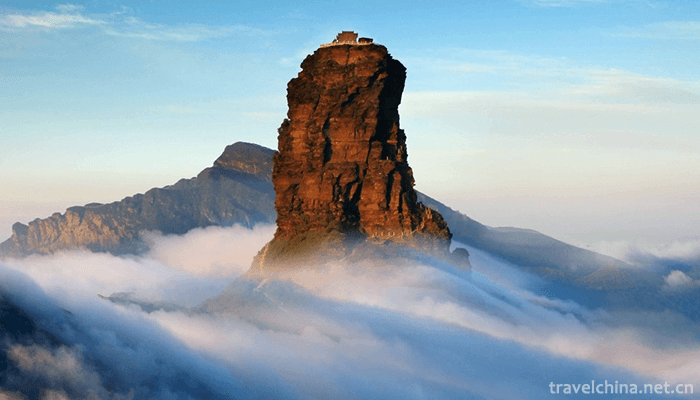
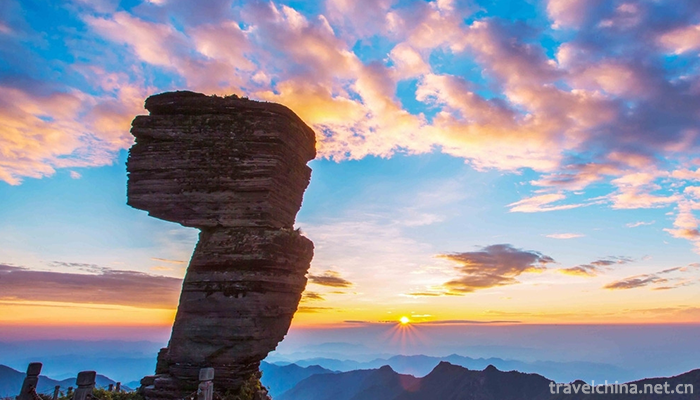
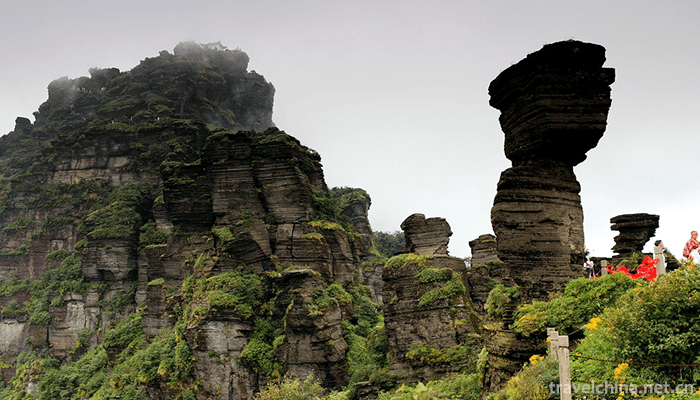
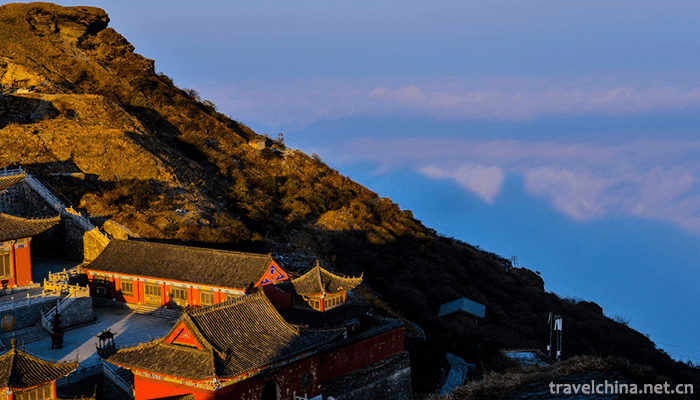

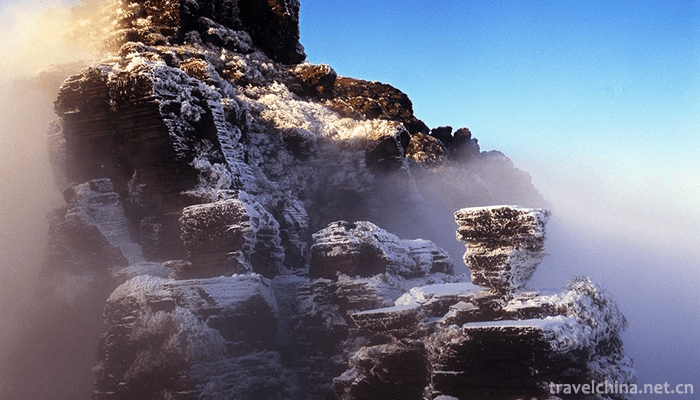
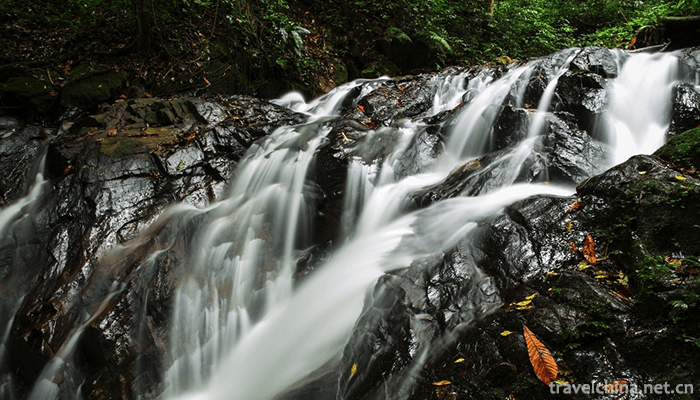
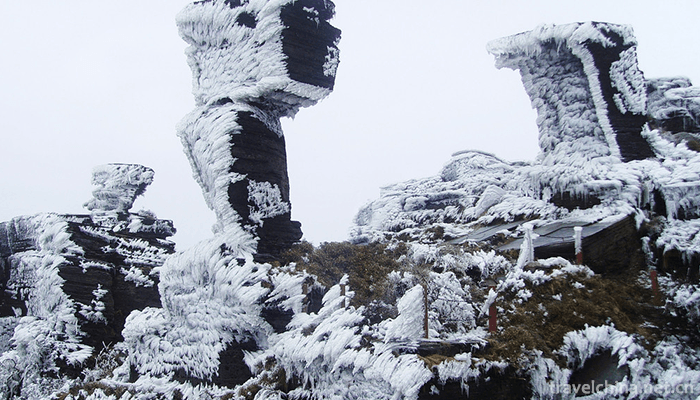
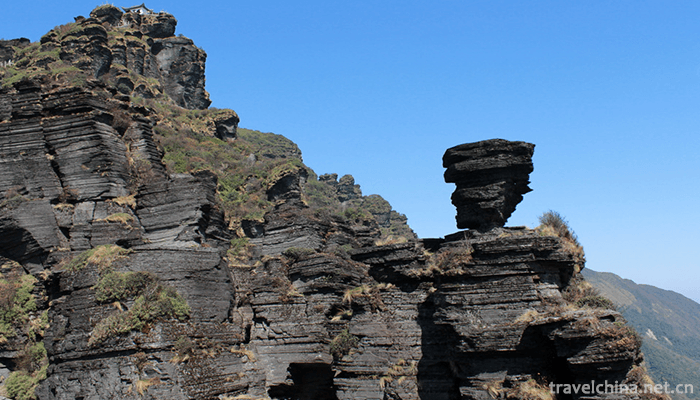
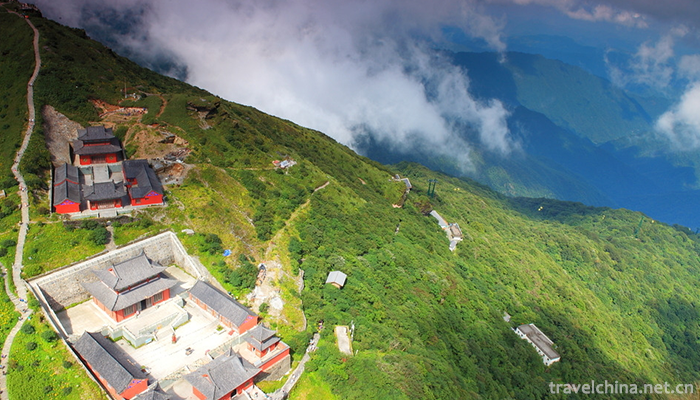
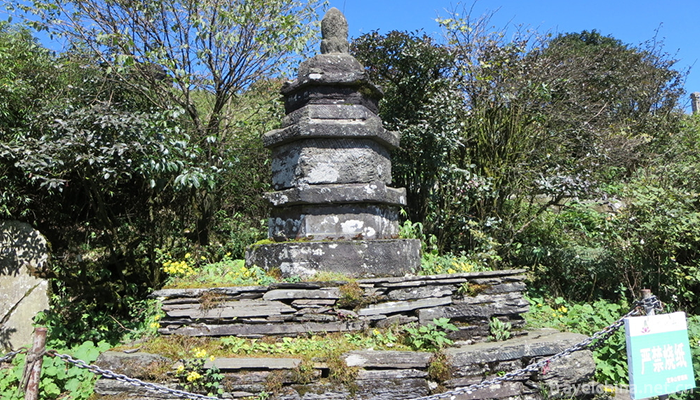
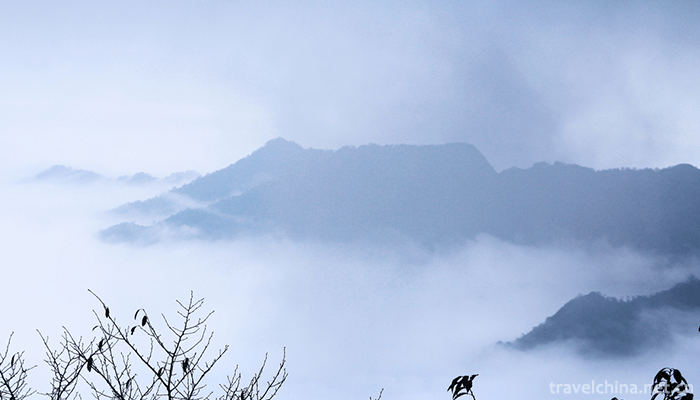
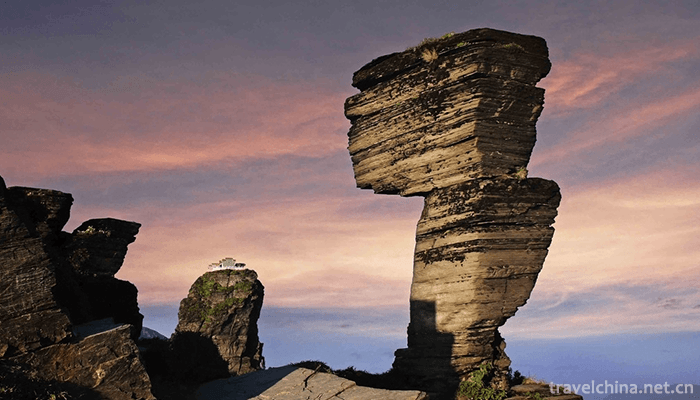

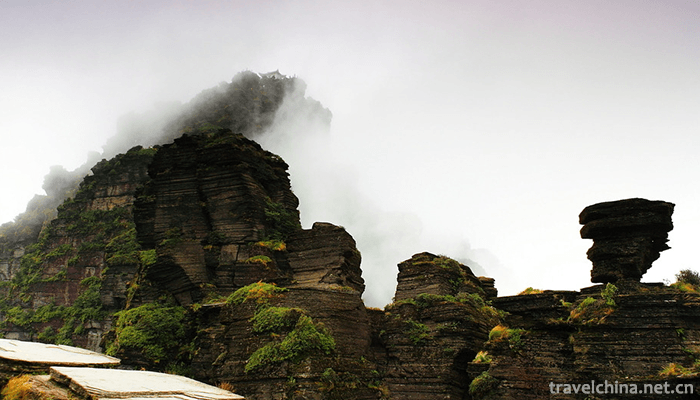
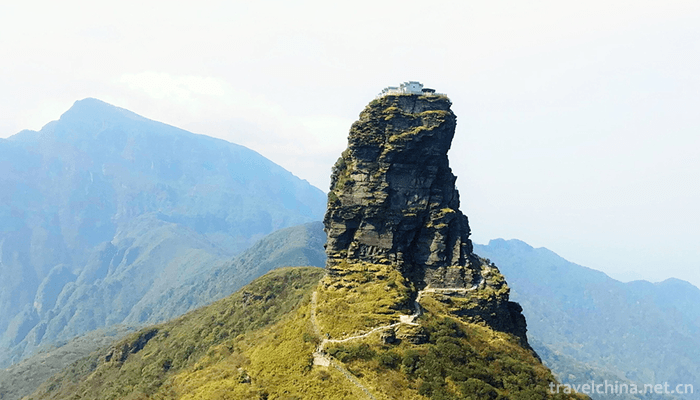

-
1.Hanguguan Historical and Cultural Tourist Area
Hangguguan Historic and Cultural Tourist Area is a national AAAA-level scenic spot built by Lingbao Municipal Committee and Municipal Government with an investment of 589 million yuan.
Time 2018-12-26 -
2.Shi Bao Village
Shibaozhai, a national AAAA-level tourist attraction, a national key cultural relic protection unit, is one of the 30 best new tourist landscapes in the Three Gorges of the Yangtze River,
Time 2019-02-08 -
3.Shimen Xianhu Scenic Area
Shimen Xianhu Scenic Area is the first national 3A-level tourist scenic spot in Rongan County, located in Liuzhou, Guangxi. It has high Gorges out of Pinghu Lake
Time 2019-02-08 -
4.Wild Elephant Valley in Xishuangbanna
The Wild Elephant Valley in Xishuangbanna is located in Mengzi Nature Reserve and "UNESCO Man and Biosphere Reserve" of Xishuangbanna National Nature Reserve
Time 2019-02-25 -
5.Song of Sichuan river
Chuanjiang chant is a kind of traditional folk singing form that the shipworkers in Chuanjiang valley of Sichuan and Chongqing area lead the singing by the trumpeters for unified movement and rhythm
Time 2019-04-19 -
6.Daur traditional Hockey
Daur's traditional hockey sport is called "Bei Kuo Taj Ke Bei" in Daur language. Bei Kuo refers to a bat. The Daur bat is made by grinding oak wood with curved roots and straight branches. I
Time 2019-04-22 -
7.Firing Techniques of Fengxi Porcelain
Fengxi Porcelain Firing Technology, a local traditional technology in Fengxi District, Chaozhou City, Guangdong Province, is one of the national intangible cultural heritage.
Time 2019-04-29 -
8.Qin an Xiaoqu
Qin'an Xiaoqu, also known as the old tune of Qin'an, is one of the national intangible cultural heritages. It is an ancient traditional folk art variety formed and mainly popular in Qin'an and other c
Time 2019-06-10 -
9.Shaoxing Xuanjuan
Shaoxing Xuanjuan is a traditional rap art with religious color, which is mainly used to worship gods and pray for blessings. Since Tang Dynasty, it has developed into folk art in Qing Dynasty. The So
Time 2019-06-14 -
10.Legend of Su Xian
The legend of Suxian is a local folklore with a long history. Su Xian, Ming Lian, from Guiyang. Su Da lost his father in his early years and depended on his mother for his life. One year, the plague w
Time 2019-06-17 -
11.Neijiang social security
In 2019, there were 109600 people participating in the endowment insurance (including retirees) of government institutions, 842500 people of enterprise employees (including retirees), and 1501700 people of urban and rural residents. 52100 new urban jobs
Time 2020-12-16 -
12.Nanchong cultural undertakings
By the end of 2019, Nanchong has 10 cultural centers, 242 cultural stations and 10 public libraries. There are 8 museums, 28 cultural relics protection and management institutions, 18 national key cultural relics protection units, 112 provincial-level cultural relics protection units
Time 2020-12-17